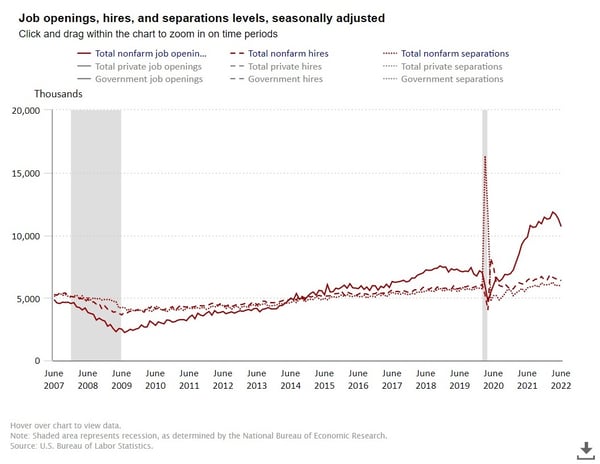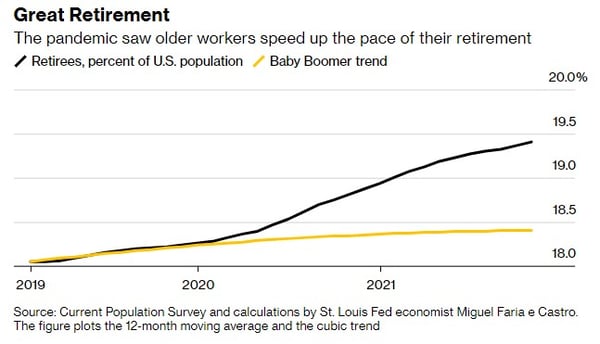When I ask business owners about the challenges facing their business, there is one common theme that runs across all industries — the labor dilemma.
By now, we have all experienced the effects of the “Great Resignation.” Local businesses have shortened operating hours, closed on certain days or reduced menu offerings because they simply cannot find enough workers. Some clothing retailers have even closed dressing rooms, citing being short-staffed as the reason.
Where are all the workers?
This is a question that business owners and consumers alike ask themselves daily.
If we know one thing to be true, it’s that the COVID-19 pandemic completely disrupted the U.S. labor market. However, it’s now been two and a half years since the nationwide shutdowns, and the labor market has yet to recover. Unemployment insurance benefits and relief payments have dried up. So, where are all the workers? Before we investigate this question more deeply, let’s first take a look at current and historical employment data.
Employment Trends
Labor participation rate is the number of people in the labor force as a percentage of the civilian, non-institutional population. It is the percentage of the population either working or looking for work. According to the U.S. Bureau of Labor and Statistics (BLS), the U.S. labor participation rates for the period January 2012 to December 2018 ranged from 66.9-67.9%. Thus, for seven years, there was only a 1.0% deviation in the U.S. labor participation rate.
From January 2019 to March 2020 (pre-pandemic), the labor participation rate steadily increased each month until it topped out at 69.5%. During the pandemic, the rate plummeted to a low of 65.9%, where it continued to sit as of June 2022. Clearly, there has been a substantial decline in the number of U.S. civilians working or seeking employment.
The U.S. BLS established the Job Openings and Labor Turnover Survey Program (JOLTS) in December 2000 to track the rate of job openings, new hires and turnover. One employment indicator tracked by JOLTS is quit rate. Quit rate is the number of quits during the month as a percentage of total employment. Quit rates tend to rise during economic expansion, when workers’ prospects for finding a better job brighten. Further, quit rates are typically higher in jobs that are low-paying vs. jobs that are high-paying.
Over the last year, the quit rate has reached highs not seen since the start of JOLTS. The quit rate rose from 1.6% in April 2020 to 3.0% in November 2021, a gain of 1.4%. This may not seem substantial; however, economists have deemed a deviation of 0.2% to be significant. Therefore, our country is experiencing labor turnover and quitting at unprecedented levels.
As shown in the chart below, job openings immediately prior to COVID were in excess of 5 million as compared to over 10 million job openings as of June 2022. The number of unfilled jobs has doubled since the pandemic began.
 Source: U.S. Bureau of Labor & Statistics
Source: U.S. Bureau of Labor & Statistics
Now that we have reviewed labor participation data and quit rates, let’s investigate why some workers have not re-entered the labor force post-pandemic. In an article published by the Harvard Business Review in March 2022, authors Joseph Fuller and William Kerr highlighted three possible explanations for the labor crisis that business owners are facing today: retirement, reconsideration and reshuffling.
The Great Retirement
In 2021, older workers left their jobs at an accelerated rate, and they did so at younger ages. This segment of our Baby Boomer population made retirement decisions out of a desire to spend more time with loved ones and to focus on priorities beyond work. As shown in the chart below, the percentage of our retired population increased well over the expected growth curve.
 Source: U.S. Bureau of Labor & Statistics
Source: U.S. Bureau of Labor & Statistics
Amidst the uncertainty of a global pandemic, the U.S. economy was booming. The S&P 500 peaked at $4,793.06 in December 2021, which was a record close. The real estate market also exploded. When the pandemic was declared a national emergency, the median home value in Maryland was $317,000. Two years later, the median home value rose to nearly $390,000, an increase of 23%. Given the state of the economy, a large segment of the older population felt they had accumulated enough wealth to retire. This surely contributed to the decrease in the labor participation rate noted above.
The Great Reconsideration
At the height of the pandemic, people everywhere faced hardships of illness and death. It seemed like we were reminded daily by the media about the number of new COVID cases and COVID-related deaths. This caused some to reconsider the role of work in their lives. Shifts in perspective prompted people to quit. Wealth creation and individual achievement became less meaningful, while the desire to enjoy the simplicities of life rose in importance for many workers.
The Great Reshuffling
As a result of the Great Retirement and Great Reconsideration, the number of job openings skyrocketed. Given the increased availability of work, there has been a substantial reshuffling of employees. Workers in the hospitality industry, especially, began to reconsider their places of employment. Why work a physically demanding job with low pay and long hours when higher-paying, remote work opportunities are everywhere?
Per the U.S. BLS, the quit rates for the accommodation and food service industry were 9.5% and 6.9% as of June 2021 and June 2022, respectively. While quit rates in this industry are ordinarily higher than the quit rates of other, more stable industries like the financial services industry or public sector, these rates are still extremely high. Both the retail trade and non-durable manufacturing industries also experienced all-time highs in quit rates.
The Labor Shortage’s Impact On Inflation
By now we’ve all heard about the supply chain crisis and its impact on the rising prices of goods and services. However, little has been spoken about the labor shortage and its contribution to inflation. According to the U.S. BLS, there was a 10% change in the price of food and beverages from June 2020 to June 2021. This increase is felt throughout the supply chain.
Let’s take sliced bread, for example. As noted above, the non-durable manufacturing industry experienced unprecedented rates of quitting. If a bakery product manufacturer cannot find plant workers, it needs to make the position more attractive. To do so, it either increases wages or enhances benefit offerings. When the cost to produce increases, the selling price must also increase. We see this in the increased price of sliced bread at the grocery store and sandwiches at our local restaurants.
Future Outlook
Given the negative effects on business and the overall economy, the labor crisis is not sustainable. Industries must grow and adapt in order to survive. Once the industry adapts, the labor pool will follow suit.
We are currently in our fourth iteration of the Industrial Revolution, known as “Industry 4.0.” The first Industrial Revolution was marked by the creation of the steam engine and mechanization. In the second Industrial Revolution, we were introduced to the assembly line and technological electrification. The third Industrial Revolution brought on the emergence of computers, robotics and digital manufacturing technologies.
With Industry 4.0, the machine becomes autonomous through machine learning and artificial intelligence. Converging information technology and data analytics will replace the manual labor jobs of old. While some manufacturing jobs will be lost with Industry 4.0, better, higher-paying jobs will be created.
Industry 4.0 is just one example of how business evolution can impact the labor market. Industries facing the highest turnover and quit rates need to be innovative in order to solve their labor problems. Without industry innovation, who knows when the labor supply and demand will balance.
Need Help?
While we aren’t going to single-handedly fix the labor crisis, understanding the causes behind it — and embracing the need to innovate — will get us closer to seeing a market adjustment.
Contact us here or call 800.899.4623.


